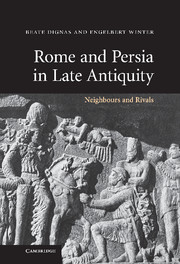Book contents
- Frontmatter
- Contents
- List of figures
- List of maps
- Preface
- Abbreviations
- Introduction: West and East, friend and foe, counterpart and mirror image …
- PART I NARRATIVE
- PART II SOURCES AND CONTEXTS
- 1 Political goals
- 2 Warfare
- 3 Military confrontations
- 4 The diplomatic solutions
- 5 Arabia between the great powers
- 6 Shared interests: Continuing conflicts
- 7 Religion: Christianity and Zoroastrianism
- 8 Emperor and King of kings
- 9 Exchange of information between West and East
- Appendix 1 Lists of Sasanian kings and Roman emperors
- Appendix 2 Chronological table
- Appendix 3 Glossary
- Bibliography
- Index of sources
- Index of translated sources
- Index of names
- Index of place names
- General index
7 - Religion: Christianity and Zoroastrianism
Published online by Cambridge University Press: 05 June 2012
- Frontmatter
- Contents
- List of figures
- List of maps
- Preface
- Abbreviations
- Introduction: West and East, friend and foe, counterpart and mirror image …
- PART I NARRATIVE
- PART II SOURCES AND CONTEXTS
- 1 Political goals
- 2 Warfare
- 3 Military confrontations
- 4 The diplomatic solutions
- 5 Arabia between the great powers
- 6 Shared interests: Continuing conflicts
- 7 Religion: Christianity and Zoroastrianism
- 8 Emperor and King of kings
- 9 Exchange of information between West and East
- Appendix 1 Lists of Sasanian kings and Roman emperors
- Appendix 2 Chronological table
- Appendix 3 Glossary
- Bibliography
- Index of sources
- Index of translated sources
- Index of names
- Index of place names
- General index
Summary
From the third century onwards the religious policy of the great powers formed an important part of Roman–Persian relations. Evidently, there was an interaction between religion and foreign relations, and developments in West and East not only were of the same character but also took place simultaneously. This means that Rome and the Persian Empire dealt with religious matters in a comparable way and that the state of religious affairs in the East and in the West affected the neighbour's course of action. In particular after the dramatic religious changes during the reign of Constantine the Great the conflict between the now Christian Rome and the Zoroastrian Sasanian Empire escalated, also ideologically.
Religion and kingship in the Sasanian Empire
First, let us examine the situation in the Sasanian Empire. Here, the doctrine of Zarathustra became the privileged religion and developed into a supporting pillar of Sasanian kingship. Zoroastrianism was therefore the religion of the Sasanian rulers and furthered by them in an exceptional way. The religious development aimed at and entailed a concentration of royal power and a centralisation of rule. This formed a stark contrast to the situation during the Parthian rule. During the Parthian period religious matters in Iran were characterised by an extremely tolerant attitude of the state towards other religious movements to the effect that Eastern and Hellenistic cults mixed profoundly.5 Just as in other regards, after the change of rule in 224 we observe a politically motivated return to old Persian traditions. The beginning of Sasanian rule therefore was an important benchmark in the religious history of Iran.
- Type
- Chapter
- Information
- Rome and Persia in Late AntiquityNeighbours and Rivals, pp. 210 - 231Publisher: Cambridge University PressPrint publication year: 2007



